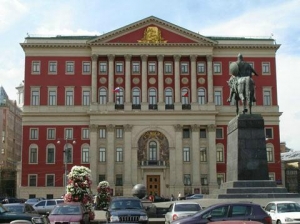Moskau +7-495-505-63-25
Sankt Petersburg +7-812-309-57-60
Excursions with City Hall
Tverskaya Str, 13,

The splendid two-storied palace in Classicism style was put up in 1778-1782 by architect M. Kazakov. The building was intended for Moscow Governor-General Z. Chernyshev, the one who was in command of Russian army when it captured Berlin in 1762 during the Seven-year war with Prussia. After Chernyshev's death the palace was possessed by the state treasury, and in 1791 rebuilt by Kazakov. Since the end of the 18th century the palace was used as the residence of Moscow Governors-Generals.
The new monumental three-storied building topped with the pediment was constructed along the «red line» of the street. The term «red line» in town-planning means the conditional line that divides the street from the territory intended for construction works. Behind the house there was the yard fenced in the side wings that were demolished in 1929-1930.
After the Great October Revolution of 1917 the Moscow Soviet occupied the building. And in 1937-1938, when Tverskaya Street was reconstructed, the mansion was moved to the new «red line».
In 1944-1946 the mansion on Tverskaya Street was rebuilt by architect D. Chechykin. The main facade was decorated with thick columns, and the two classicism-style floors with eight-columned portico, round windows and sculptural medallions were overbuilt. Bright colors (red walls, white moldings, gildings) emphasized the mansion's importance and significance.
Nowadays the building houses the City Hall. The pediment is decorated with the city coat of arms, which is a relief depicting Saint George. The interior of the mansion features a part of original decoration, including gala-staircase, the Red and the White Halls faced with artificial marble, gala suite adornments, ceiling paintings that were restored by artist P. Korin.
In front of the House of Moscow Governors-Generals Tverskaya Square is located. Two hundreds years ago it did not have the name. It served as a drill ground where the guard trainings took place. Since the middle of the 19th century the square got the name of Tverskaya, and in 1912 it was called Skobelevskaya. General Skobelev was the hero of Russian-Turkish war of 1877-1878, and was in command of Russian troops in battles for Bulgaria liberation. The monument to Skobelev was put in the middle of the square. In April, 1918 the monument was removed, and the pedestal was turned into the rostrum.
After some time the monument to the First Constitution of the Russian Soviet Federative Socialist Republic was placed in the square. The monument was designed by sculptor N. Andreev. The square got the name of Sovetskaya. After World War II the monument that was in poor condition was replaced. In 1954 the square was decorated with the monument to the founder of Moscow, Prince Yuri Dolgoruky. The monument became the symbol of the Russian capital. Recently the square has been given its original name — Tverskaya.
Hotels in der Nähe
Ararat Park Hyatt
Neglinnaya Str. 4
Das Ararat Park Hyatt Hotel liegt im Stadtzentrum, in Moskau, gegenüber dem Roten Platz und nur wenige Schritte
ab 11068
pro Nacht
National
Mokhovaya Str., 15/1
Das Hotel "National" wurde im Jahre 1903 vom berühmten russischen Architekten Alexander Ivanov in einem
ab 0
pro Nacht
Budapest
2/18 Petrovskiye Linii St.
The Budapest Hotel is located in the historical district of Moscow, close to the main business and cultural centers
ab 0
pro Nacht
Peter I
Neglinnaya Str., 17
Das Peter I Hotel liegt im Stadtzentrum, in Moskau, nur 100 Meter vom Bolshoi Theater und 500 Meter von Rotem Platz
ab 0
pro Nacht
Ritz-Carlton
Tverskaya St., 3
The modern luxury The Ritz-Carlton, Moscow Hotel is conveniently situated in the center of business and cultural
ab 0
pro Nacht
Sehenswürdigkeiten von Moskau
- Monuments
- Attractions











